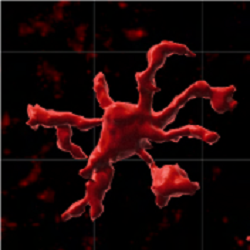
A new pathway of autophagy regulation has been identified from Prof. David Rubinsztein’s group at CIMR, which is also part of the UK Dementia Research Institute at Cambridge. Publishing in Neuron, Dr Beatrice Paola Festa, Dr Farah Siddiqi, Dr Maria Jimenez-Sanchez and colleagues showed at early stages of disease pathology, activated microglia in cellular and mouse models of neurodegeneration produce chemokines which in turn, activate the CCR5 receptor in neighbouring neurons. This paracrine pathway suppresses the initiation of neuronal autophagy – a process otherwise required to counter the toxic build-up of specific proteins which drive neurodegeneration. Further experiments showed that genetic and pharmacological targeting of CCR5 activation using maraviroc (a licenced anti-HIV drug designed to block the virus from entering host cells) can up-regulate autophagy in mouse models of Huntington’s disease and tau-driven neurodegeneration, thereby reducing pathology. This finding may open up new, much-needed therapeutic approaches to these devastating conditions.

